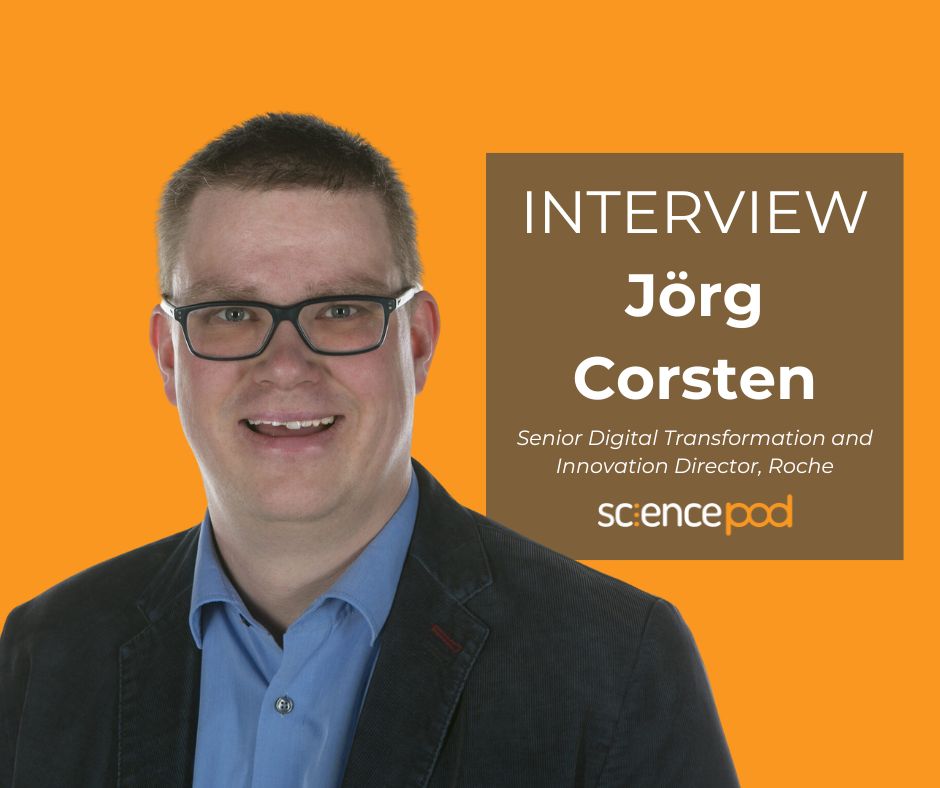Interview with Jörg Corsten, Senior Digital Transformation and Innovation Director, Roche
“You need to have a really solid foundation for your scientific communication and your marketing activities. This needs to be accompanied by solid ethics and a strong vision about how you can collaborate with and for patients and physicians,” says Jörg Corsten, Senior Digital Transformation and Innovation Director at Roche
SciencePOD had the opportunity to speak with Jörg in advance of his presentation at Reuters Events Pharma 2022. The event will run from 11–13 October at the Nice Acropolis Convention Center, Nice, France, and Jörg’s presentation is entitled “Case Study: Build patient trust, increase patient interactivity and streamline your product’s pathways to market.”
“As a pharmaceutical company, we need to be extremely reliable, and we need to be alert to circumstances where we could conceivably break trust with patients or physicians and avoid those issues before they arise.”
– Jörg Corsten
Could you tell us a bit about your role in your company?
The role of our team at Roche is to form a bridge between science and commercialization. Medical affairs finds itself exactly in the middle between these two areas, and has a double hinge function between late-stage clinical trial development and launch activities.
Our role in the digital sphere is to ensure that we have the correct workflow services in place so that we can be really effective and efficient in our customer engagement, which will hopefully lead to a good uptake of new products and ultimately benefits patients.
What is the biggest challenge in your digital transformation right now?
One challenge is associated with the size of the company. It is a complex company and it has a very diversified strategy when it comes to diagnostics and pharmaceuticals, and the pharma arm includes various areas, such as neuroscience, immunology, ophthalmology and oncology.
Therefore, we are serving a wide spread of customers and we have developed and introduced treatments for these disease states at different times. One of the biggest challenges is that we have heritage systems, systems that could be working closer together and new processes. The key challenge is making systems and processes and people work more effectively together.
Could you give us an example where you have successfully implemented new digital processes in your market access approach?
I think it’s useful to note that classically defined market access is not the only consideration, but the most important thing is that the whole company and our products are accessible to the customer. We need to think about this holistically. There was a recent study that looked at the key drivers of trust in customers, and accessibility was one of these. This includes accessibility of information and accessibility to the science behind our treatments. It is important that this information is tailored so that customers can understand and utilize it. Our audience has widespread knowledge and not everyone just needs a scientific paper or just a layperson’s summary.
At present, the issue is building a bridge between clinical trial data and the publications based on those data and then contextualizing these data and explaining why they are important. Transparency and consistency are really important here. Here are the data, here is the publication and here is what we think about it.
What is the importance of using different content formats/types in your digital strategy?
I hesitate to think about this from a digital strategy standpoint alone. I think the most important thing is to be customer-oriented. We all know that there are physicians out there who love to get the details and the data, and there are those who simply wish to know what is in this development for their patient or themselves. Then there are those who take a “Be quick, be gone” approach, and require us to be really effective with their time.
We need to translate those needs into appropriate content formats. For instance, a long manuscript that is published in a peer-reviewed journal appeals to only one of those groups. However, a tweetable infographic serves another group and a peer-reviewed video on the topic serves yet another group. It is important to realize that our customers are not a monolith, and tailoring content serves to keep the information relevant and appealing for each type of customer across the various channels.
What is the single key takeaway message you have for Reuters Event Pharma 2022 attendees?
You need to have a really solid foundation for your scientific communication and your marketing activities. This needs to be accompanied by solid ethics and a strong vision about how you can collaborate with and for patients and physicians. As a pharmaceutical company, we need to be extremely reliable, and we need to be alert to circumstances where we could conceivably break trust with patients or physicians and avoid those issues before they arise. Attention to detail is key here.

